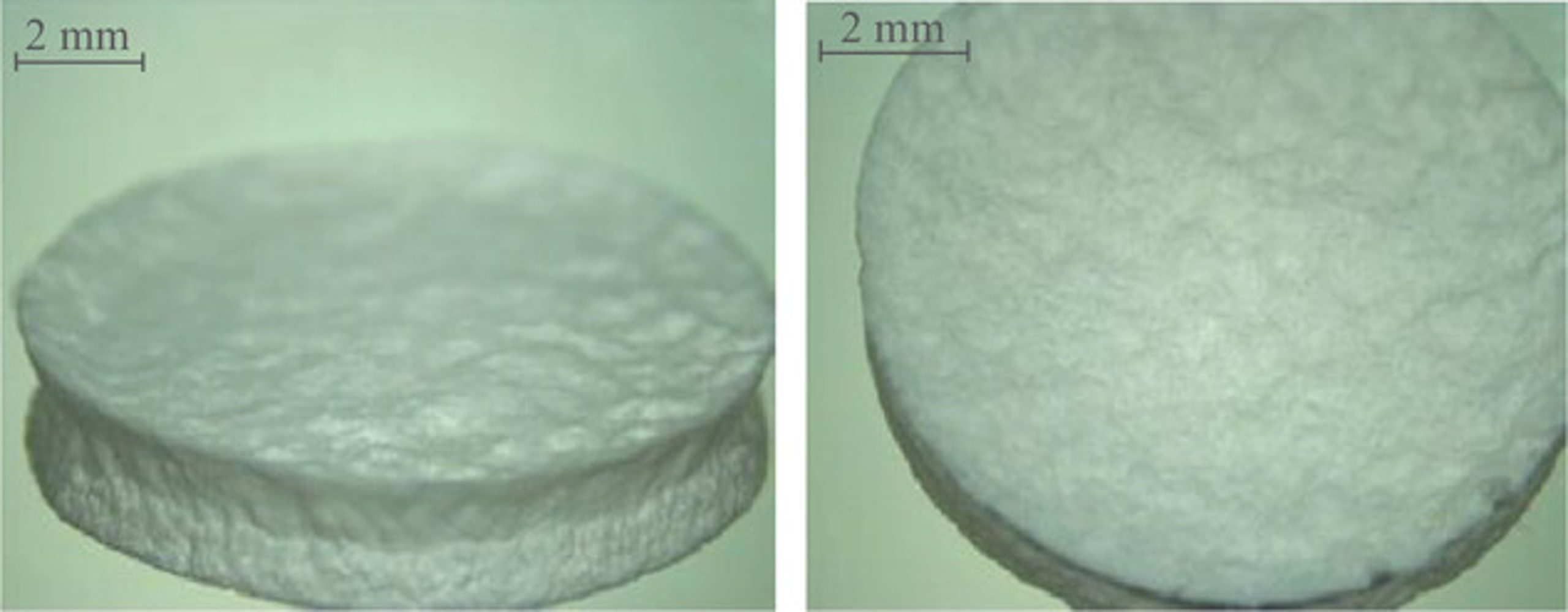Transdermal Administration of Nanobody Molecules using Hydrogel-Forming Microarray Patch Technology: A Unique Delivery Approach

Abstract
Nanobody molecules, derived from heavy-chain only antibodies in camelids, represent the next generation of biotherapeutics. In addition to low immunogenicity, high stability, and potency, their single-domain format facilitates the construction of multivalent molecules for therapeutic applications. Although predominantly administered using a hypodermic syringe and needle, alternative delivery methods are under investigation. That said, the transdermal route has yet to be explored. Therefore, microarray patch (MAP) technology, offering a potentially high dose, pain-free transdermal system, is employed in this study. Trivalent Nanobody molecules, with and without half-life extension (VHH and VHH[HLE]), are formulated into hydrogel-forming MAPs, with pharmacokinetic parameters assessed in Sprague–Dawley rats. VHH MAPs exhibited a sustained release profile, with a serum concentration of 19 ± 9 ng mL−1 24 h post-administration. In contrast, a subcutaneous (SC) injection showed faster clearance, with a serum concentration of 1.1 ± 0.4 ng mL−1 at 24 h. For VHH(HLE), both SC and MAP cohorts achieved a maximum serum concentration (Tmax) at 24 h. The MAP cohort displayed a notable increase in VHH(HLE) serum levels between 6–24 h, dropping after MAP removal. This study has exemplified MAPs potential for delivering advanced biologics, indicating the transdermal route’s promise for pain-free, patient-friendly administration of Nanobody molecules.
Introduction
It is well established that all camelids have unique antibody-like structures that play a key role in the host immune response. In contrast to the well-conserved structure of immunglobulin G (IgG) in mammals, which consists of two heavy chains and two light chains, camelids possess an additional IgG isotype composed of a homodimer of heavy chains only.[1, 2] The lack of a light chain therefore reduces the antigen-binding fragment to a single variable domain, termed VHH (which is the basis for Nanobody molecules). Owing to this simplified, single-domain format the construction of multivalent molecules for therapeutic applications is less expensive than that for monoclonal antibodies (mAbs). One such therapeutic Nanobody molecule, caplacizumab, is a bivalent domain that has been designed to target the ultra-large von Willebrand factor, a glycoprotein that plays a key role in acquired thrombotic thrombocytopenic purpura (aTTP), a rare blood disorder in which platelet aggregation leads to microvascular thrombosis.[3] This treatment strategy has had a positive impact on TTP patients, with those on caplacizumab 1.55 times more likely to achieve a recovery of their platelet counts when compared to standard plasma exchange therapy.[4] This is one example of the therapeutic potential of this next generation of biologics.
Nanobody molecules are also intrinsically stable molecules that can bind to conformational epitopes that may be otherwise inaccessible to mAbs due to their extended complimentary-determining region (CDR3) loops.[5] The enhanced stability has enabled Nanobody molecules to withstand different administration routes. For instance, ALX-0171, a homotrivalent construct that specifically targets human respiratory syncytial virus (hRSV) has been successfully administered via inhalation. Nanobody molecules have also been investigated for the treatment of mucosal infectious diseases caused by enterotoxigenic Escherichia coli (ETEC).[6] This is estimated to cause ≈380 000 deaths annually during sporadic or epidemic outbreaks worldwide. Oral administration of Nanobody molecules led to a significant reduction of bacterial colonization in a mouse model. Moreover, Nanobody molecules extended the inhibitory activity in mouse colonization compared to commercial hyperimmune bovine colostrum products used for the prevention of ETEC-induced diarrhea.
Currently, the delivery of Nanobody molecules via the transdermal route has yet to be investigated. Clearly, these novel biomolecules do not possess the required properties for passive diffusion through the stratum corneum. Therefore, a traditional transdermal patch could not deliver therapeutic doses of Nanobody molecules to the systemic circulation. To this end, microarray patch (MAP) technology is a credible option to overcome the stratum corneum to deliver Nanobody molecules directly to the dermis and subcutaneous layers. This would have a number of advantages over the intravenous (IV) or subcutaneous (SC) route, such as pain-free administration, increased patient acceptance, prevention of needle stick injury, and elimination of sharps disposal. Furthermore, previous work has shown that repeat application of hydrogel-forming MAPs does not lead to prolonged skin reactions or prolonged disruption of skin barrier function.[7] Therefore, this work investigates the feasibility of delivering two trivalent model Nanobody molecules transdermally using two separate hydrogel-forming MAP systems by directly comparing the pharmacokinetic profile of this delivery system in Sprague–Dawley rats with an SC injection, currently the preferred method of administration. More specifically, a Nanobody molecule (named VHH) with a molecular weight (MW) of 45 kDa will be incorporated into a hydrogel-forming MAP system. This is a trivalent construct composed of three VHH domains that have no endogenous target in rat models thus enabling the general pharmacokinetic (PK) behavior of the Nanobody molecule to be assessed. The second Nanobody molecule (named VHH(HLE) has been designed to improve the PK properties, that is, extension of half-life in systemic circulation by binding to rat serum albumin. Again, this is a trivalent construct with a MW of 45 kDa, composed of two VHH domains that do not bind to any rat target and one anti-albumin VHH domain. Binding to albumin as a carrier has been shown to lead to retention of the bound protein in circulation, with a resident time ≈376-fold higher than its VHH counterpart in cynomolgus monkeys.[8] Therefore, formulation and delivery of both VHH and VHH(HLE) from a hydrogel-forming MAP will provide insights into manufacturing development and the therapeutic potential of a unique transdermal delivery system for Nanobody molecules.
Download the full article as PDF here: Transdermal Administration of Nanobody Molecules using Hydrogel-Forming Microarray Patch Technology
or read it here
Materials
HH solution (59.3 mg mL−1) and VHH(HLE) solution (50.4 mg mL−1) were obtained from Sanofi Ghent, Technologiepark 21, 9052 Zwijnaarde, Belgium. Avastin concentrate solution for infusion 25 mg ml−1 was purchased from Roche Welwyn Garden City, Hertfordshire, UK. Gantrez S-97, a co-polymer of methyl vinyl ether and maleic acid (PMVE/MA) was a gift from Ashland, Kidderminster, UK. Poly (ethylene glycol) (PEG) with MW = 10 000 Da, was purchased from Sigma-Aldrich, Steinheim, Germany. Sodium carbonate (Na2CO3) was purchased from BDH Laboratory Supplies, London, UK. Poly(vinylpyrrolidone) (PVP), MW 58 kDa, sold under the product brand name Plasdone K-29/32, was obtained from Ashland, Switzerland. Poly(vinyl acetate) (PVA), MW 85 000–124 000 Da was purchased from Sigma Aldrich, Steinheim, Germany. Citric acid was obtained from BHD Laboratory Supplies, Poole, UK. Cryogel SG3 was provided by PB Gelatins, Pontypridd, UK. Pearlitol 50C-Mannitol was supplied by Roquette, Lestrem, France. Sodium chloride (NaCl) was purchased from Sigma Aldrich, Steinheim, Germany NuPAGE Bis-Tris 4–12% 1.5 mm 10 well gel, SeeBlue Plus 2 Pre-stained protein standard ladder, Coomassie blue R-250 dye and NuPAGE MES SDS Running Buffer were purchased from ThermoFisher Scientific, Rockford, USA. Recombinant human VEGF165 was purchased from Biolegend San Diego, USA. Biotinylated VEGF165 was purchased from antibodies-online GmbH, Aachen, Germany. 1-Step Ultra TMB-ELISA substrate was purchased from ThermoFisher Scientific, Rockford, USA.
Aaron R. J. Hutton, Melissa Kirkby, Tom Van Bogaert, Peter Casteels, Christelle Nonne, Veronique De Brabandere, Ortwin Van de Vyver, Lalit K. Vora, Ismaiel A. Tekko, Helen O. McCarthy, Ryan F. Donnelly, Transdermal Administration of Nanobody Molecules using Hydrogel-Forming Microarray Patch Technology: A Unique Delivery Approach, Macromolecular Materials and Engineering published by Wiley-VCH GmbH, First published: 18 March 2024 https://doi.org/10.1002/mame.202400029
Are you interested in our webinar:
“Rethinking the development of controlled release formulations and manufacturing processes”
Date: 30th of April, Time: 3:00 pm (Amsterdam, Berlin)


